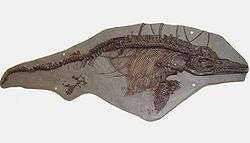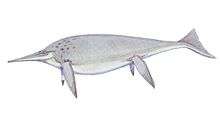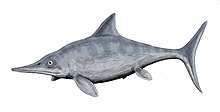Parvipelvia
Parvipelvia (Latin for "little pelvis" - parvus meaning "little" and pelvis meaning "pelvis") is an extinct clade of euichthyosaur ichthyosaurs from the Late Triassic to the early Late Cretaceous (middle Norian - Cenomanian) of Asia, Australia, Europe, North America and South America. Named by Ryosuke Motani, in 1999, it contains the basal taxa like Macgowania and Hudsonelpidia.[1] Maisch and Matzke (2000) found in their analysis seven synapomorphies that support Parvipelvia. They also found 10 synapomorphies that support the existence of post-Triassic clade of ichthyosaurs (all parvipelvians excluding Macgowania and Hudsonelpidia), for which the name Neoichthyosauria was found to be available.[2]
| Parvipelvia | |
|---|---|
 | |
| Ichthyosaurus breviceps fossil | |
| Scientific classification | |
| Kingdom: | Animalia |
| Phylum: | Chordata |
| Class: | Reptilia |
| Order: | †Ichthyosauria |
| Clade: | †Euichthyosauria |
| Node: | †Parvipelvia Motani, 1999 |
| Subgroups | |
| |
Phylogeny
Parvipelvia is a node-based taxon defined in 1999 as "the last common ancestor of Hudsonelpidia, Macgowania, Ichthyosaurus and all of its descendants".[1] Maisch and Matzke (2000) also defined Neoichthyosauria which is a node-based taxon originally named by P. Martin Sander in 2000, as "the last common ancestor of Temnodontosaurus trigonodon and Ophthalmosaurus icenicus and all of its descendants".[2] The cladograms below follows Motani (1999) and Maisch and Matzke (2000).[1][2]
| Parvipelvia |
| |||||||||||||||||||||||||||
| Parvipelvia |
| |||||||||||||||||||||||||||
References
- Motani, Ryosuke (1999). "Phylogeny of the Ichthyopterygia" (PDF). Journal of Vertebrate Paleontology. 19 (3): 472–495. doi:10.1080/02724634.1999.10011160. Archived from the original (PDF) on 2016-03-05. Retrieved 2011-10-19.
- Maisch, Michael W. & Andreas T. Matzke (2000). "The Ichthyosauria" (PDF). Stuttgarter Beiträge zur Naturkunde. Serie B (Geologie und Paläontologie). 298: 1–159. Archived from the original (PDF) on 2014-11-05. Retrieved 2018-03-20.

